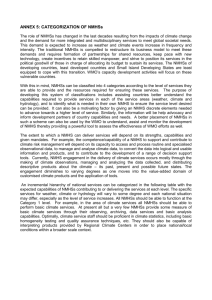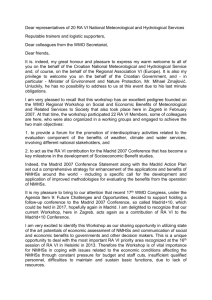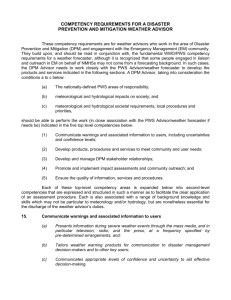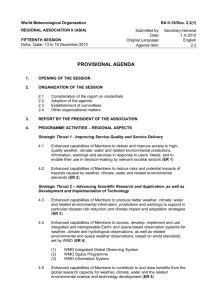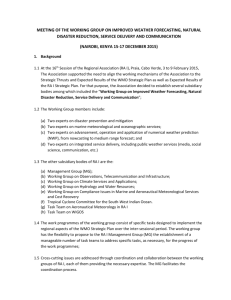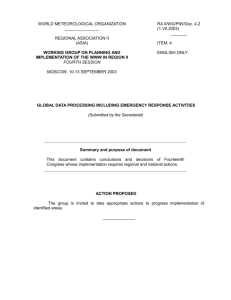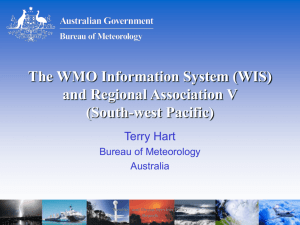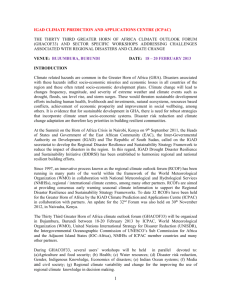Integrated and sustainable assistance
advertisement
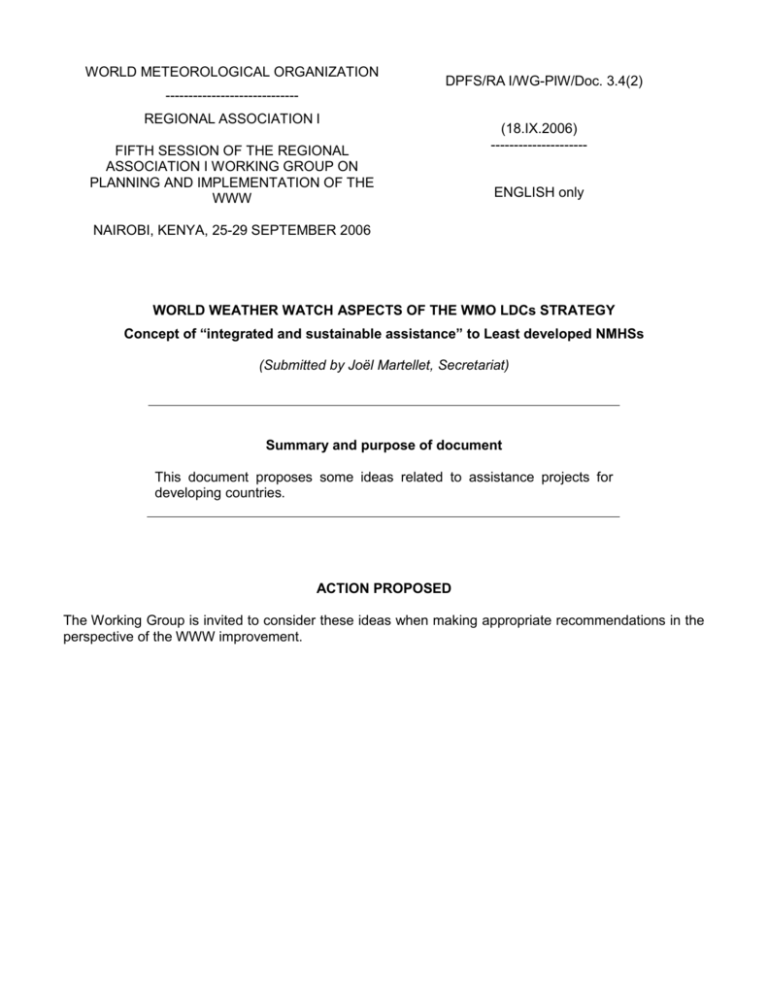
WORLD METEOROLOGICAL ORGANIZATION DPFS/RA I/WG-PIW/Doc. 3.4(2) ----------------------------REGIONAL ASSOCIATION I FIFTH SESSION OF THE REGIONAL ASSOCIATION I WORKING GROUP ON PLANNING AND IMPLEMENTATION OF THE WWW (18.IX.2006) --------------------- ENGLISH only NAIROBI, KENYA, 25-29 SEPTEMBER 2006 WORLD WEATHER WATCH ASPECTS OF THE WMO LDCs STRATEGY Concept of “integrated and sustainable assistance” to Least developed NMHSs (Submitted by Joël Martellet, Secretariat) Summary and purpose of document This document proposes some ideas related to assistance projects for developing countries. ACTION PROPOSED The Working Group is invited to consider these ideas when making appropriate recommendations in the perspective of the WWW improvement. CONCEPT OF “INTEGRATED AND SUSTAINABLE ASSISTANCE” Introduction 1. The purpose of this document is to propose ideas for optimizing the benefit of World Weather Watch capacity building projects in RA I. Donors are looking for beneficial impacts and sustainable projects. A capacity building project supported financially by external donors should be shown as delivering results to satisfy needs and requirements of beneficiaries and to motivate the donors for further help and additional funding. Key for success: integration in the chain of processes 2.. The specificity of the NMHSs is that their tasks related to the World Weather Watch are parts of an integrated production chain: making of the observations, transmission of the observations nationally (and international sharing of the observations), acquisition of the observations, processing of the observations, making the forecast or the climate products, delivery of the products through appropriate ways: bulletins, warnings, studies, TV-broadcasts, etc... 2.1. Therefore, one should concentrate on projects, which consider the integration of all the processes and deliver results in concordance with requirements, rather than projects, which are limited to single step within the chain of processes. 2.2 For example, what is the point of purchasing AWS (Automatic Weather Stations) if the observations are not delivered to the forecasting centre? Or there is no point of delivering studio facilities to a country if the national observations are not available at the NMC. The whole chain of processes from observation acquisition to delivery of meteorological information for the user community has always to be considered. Key for success: sustainability 3. Another aspect to consider is sustainability, which implies always including maintenance of the equipment delivered within the project, whether national, or through cooperation, bi-lateral or multilateral, whatever aid project. It means ensuring availability of spare parts as well as of competent technician(s) to perform the maintenance. If maintenance is not ensured, sooner or later interruption of the service will take place, and the operation will not be sustainable. Integrated and sustainable assistance 4. These facts have to be considered thoroughly when a capacity building project is designed. That is the concept of “integrated and sustainable assistance”; a project which integrates the delivered assistance within a chain ensuring correct, improved products delivered to users and which ensures the sustainability, including maintenance for continuous operational activities during the whole life expectancy of the equipments. 5. The capacity building projects can usually be put in one of this two following cases: 5.1 Case of the NMHSs not able to deliver correct forecast or climate information, and not contributing to disaster mitigation and sustainable development (considered as least developed NMHSs, most of which are in developing countries, in particular LDCs): In that case the assistance projects should be focusing on every country one by one, ensuring that in every country the whole chain from observations, through telecommunication and to data processing works and enables the delivery of useful weather or climate services through bulletins or TV broadcast, and that the project will improve the final products to be durably delivered. One should avoid distributing limited equipment concerning only limited part of the chain of processes to many countries, without considering the impacts for final products. With these principles, Meteorological Aid for Least Developed NMHSs will be a success. 5.2 Case of the NMHSs already able to deliver correct forecast or climate information, which contributes to disaster mitigation and sustainable development: In that case, the projects can be limited to one or few steps of the processes chain, provided it is demonstrated that the “plus” delivered does not affect the existing operational chain, but rather improves it. There too, maintenance should be considered and included in the implementation project for sustainability.
